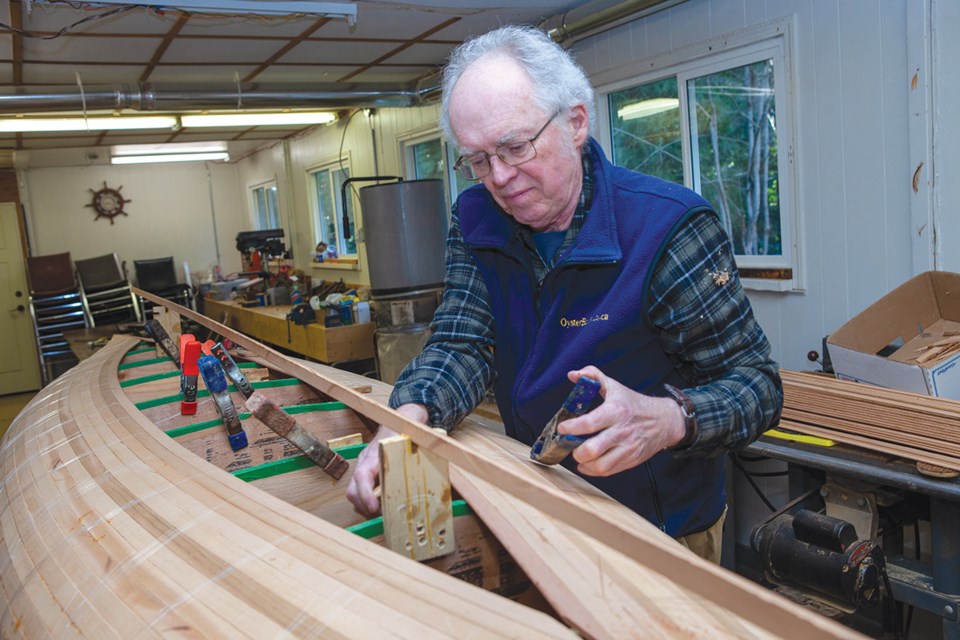A professional boatbuilder is sharing the art of handmade watercraft with learners whose labours will launch a unique fundraising vehicle for the Pender Harbour Living Heritage Society.
In January, six adults enrolled in weekly boatbuilding classes offered by Rick Crook. Crook is the proprietor of Oyster Bay Boats and a volunteer director of the Pender Harbour Living Heritage Society. In the woodshop behind the society’s headquarters at Sarah Wray Hall in Irvines Landing, Crook and his students are fashioning a 16-foot cedar strip canoe.
The two-passenger vessel will be added to the fleet maintained by the Living Heritage Society. Rental proceeds will support historical preservation and community programs led by the society, which was chartered in 2001.
Crook has fashioned more than 60 boats since moving to the Pender Harbour community two decades ago. Most of his designs are characteristic of hand-propelled fishing vessels common to the west coast over the last century. His handliner rowboat is modeled on a craft owned by one-time Roberts Creek author Hubert Evans, which is now in the collection of the Sunshine Coast Museum and Archives.
Crook’s favourite model is the “Wee Lassie” canoe, a one-person touring boat that weighs only 30 pounds. Due to the sudden shutdown of Crook’s classes due to COVID-19 restrictions, work on his latest Wee Lassie was interrupted for months. Finally complete, its gleaming keel now rests outside the double doors of the boat shed at Sarah Wray Hall.
The boatbuilding classes began when the Pender Harbour Community School invited local residents to offer instruction on areas of expertise. “I thought to myself, I bet it would be fun,” said Crook. “And it is. It’s a great time for me. I meet all sorts of interesting people and it puts me in contact with people who are interested in boats.”
Among his current cohort is a four-member family from Roberts Creek that drives to Irvines Landing once a week for hands-on experience in canoe construction.
“Some people are just curious, and sometimes people just like the experience of building something,” said Crook. “I’ve had people take the class two or three years in a row because they just like the good time.”
Crook’s technique involves fixing long slats of red and yellow cedar around wooden forms. He secures the slender strips with clamps and fishing line as they are glued into shape. The lines twang like banjo strings when they are pulled taut.
Once the hull is complete, it will be sanded smooth before a protective layer of fibreglass is applied, then flipped upright for the addition of gunnels and seats. Finally, Crook’s pupils will sand the fibreglass exterior to a high gloss.
Crook’s craftsmanship has achieved international appeal. He has shipped boats across Canada, and a couple of years ago he encountered an international buyer in the driveway of his Maderia Park home.
“It was surreal, because I’m standing there in my yard and this guy walks down the road,” Crook recalled. “He said, ‘I’ve come from Germany. I’d like to see what you’re doing. I was thinking I would like a boat.’”
The visitor ordered two custom canoes shipped to his villa in northern Italy.
Upon completion of the cedar strip canoe currently under construction, Crook says it will be added to the rental livery of the Living Heritage Society, which currently includes a handliner and two Davidson-style rowboats. A future dock on nearby Hotel Lake will serve as the flotilla’s base of operations.
The finished canoe will be doused with champagne by its builders at a maiden voyage in mid-March.



